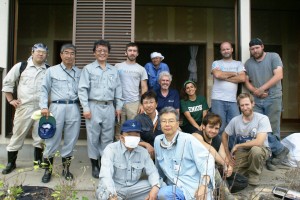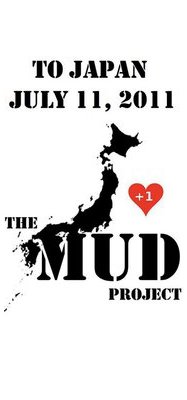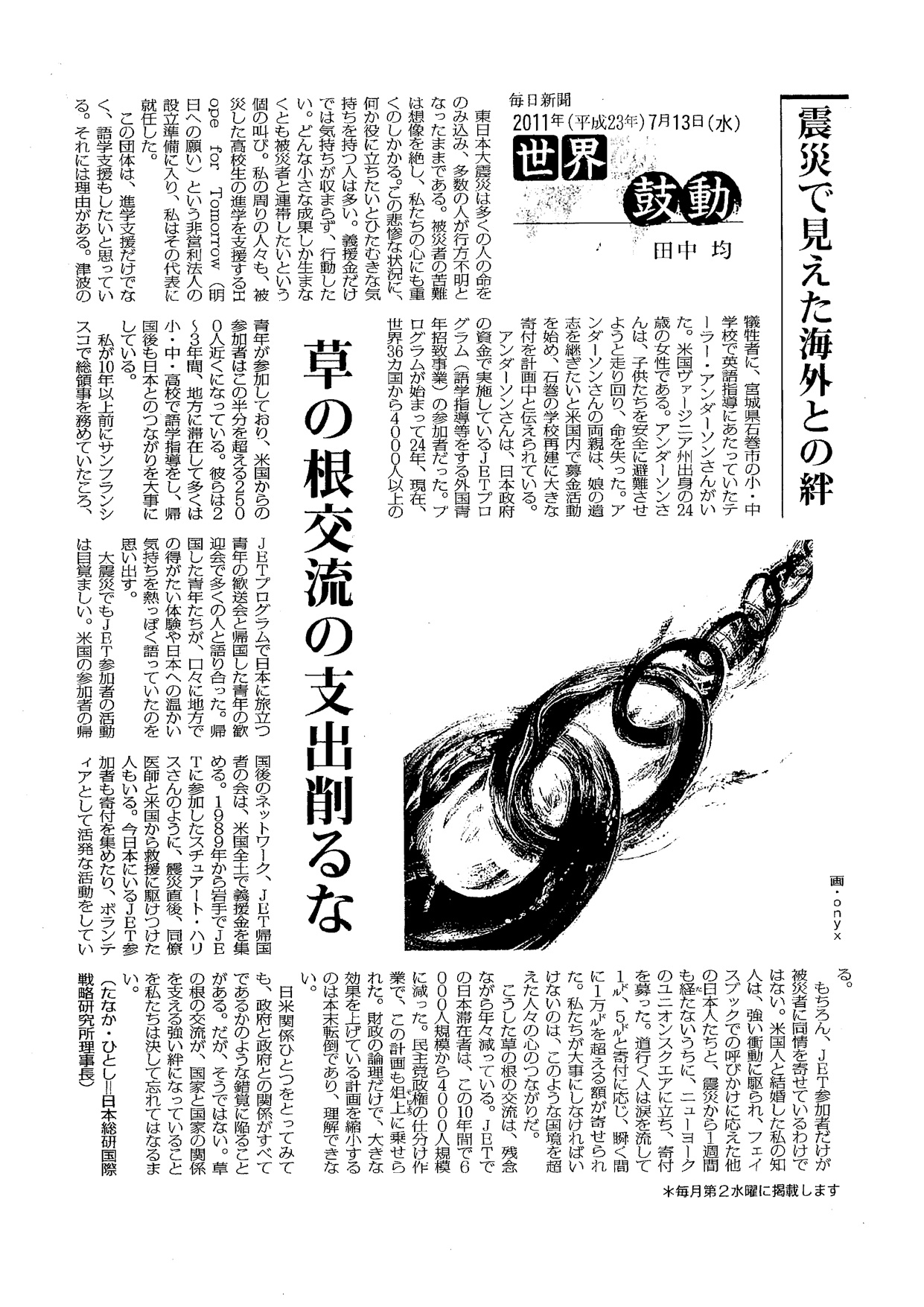Another Canadian JET to visit Tohoku via the MOFA program
Turns out the Ottowa Citizen article was not entirely correct about Brent Stirling (Fukushima-ken, Fukushima-shi, 2006-10) being the only Canadian among the 20 ex-JETs selected for the MOFA program to go back to their town/city in Tohoku, help with volunteering and write about and share their experience.
But the post on JETwit about the article did help generate a response from Toronto-based JET alum Tanya Gardecky (Miyagi-ken, Shiogama-shi) who will also be participating and whose travel blog you can follow here: http://www.travelblog.org/Bloggers/ShiogamaJET/
********************
Here are a few JET-related articles and radio piece written and produced in the past month by JET Alum Bluegrass Subchapter member Graham Shelby (Fukushima-ken). (Thanks to Graham for sharing the info.)
- Graham went to Nashville at the end of July to interview some of the new JETs about to depart from the consulate there. Here’s a radio piece he produced that aired this past week on the public radio station here in Louisville. (It’s short.)
http://www.wfpl.org/2011/08/15/audio-new-teachers-prepare-for-life-in-japan/
- Graham also put together a quick piece focusing on one of new JETs who happens to be headed to Fukushima. It aired a few times on NPR’s national newscasts during Morning Edition on August 1. They don’t archive the newscasts online, the newscaster’s intro sounded something like this:
“While many people are struggling to find jobs, hundreds of Americans, many of them recent college graduates, have found an employer eager to hire them – in Japan. From member station WFPL, Graham Shelby has more.”
- Lastly, Graham did another short piece that was Kentucky-specific that was picked up by a few stations here.http://www.wfpl.org/2011/07/30/kentuckians-prepare-for-japanese-teaching-assignments/
As Graham’s work demonstrates, there are clearly opportunities to find and tell compelling stories from the world of JETs and former JETs. If you have any ideas, angles, upcoming events or possible outlets in mind, please feel free to contact Graham gshelby3 [at] gmail.com.
***************
Ottawa based JET alum Brent Stirling (Fukushima-ken, Fukushima-shi, 2006-10) is one of only 2 Canadians out of 20 JET alumni selected to return to the Tohoku region to volunteer, engage and share their experience for the benefit of others, according to an article in the Ottawa Citizen.
(Note: This post previously repeated the error in the Ottawa Citizen article that Brent was the only Canadian participating. But it turns out that Toronto-based Tanya Gardecky (Miyagi-ken, Shiogama-shi) will also be participating.)
Stirling, who writes on his blog ForYourBrentertainment and was actively involved in the creation of Quakebook following the Tohoku Earthquake and Tsunami, submitted a proposal which was accepted by the program established by the Ministry of Foreign Affairs together with the Japan Tourism Agency to bring 20 Tohoku-area JET alums back to Tohoku to play a role in helping their communities and then spread word of their experience afterwards.
Read the full Ottawa Citizen article here: “Months of blogging leads to trip to Japan: Kanata teacher will help with disaster relief in the country he writes about”

All Hands volunteers and 3M workers take a break from tearing down drywall to enjoy a delicious bento lunch. All Hands executive director and founder David Campbell, center, T.R., second row, far right. (Eric Zdenek)
By T.R. Pearson (Shiga-ken, 2004-06) for JQ magazine. T.R. currently works in the Admission Office at Riverdale Country School in the Bronx, New York. This was his third deployment with All Hands after volunteering in Indonesia in 2006 and Bangladesh in 2008. If you’d like more information on All Hands, he can be reached at theodoreroyce[at]gmail.com.
I’m sure most JETs remember the influx of e-mails after every typhoon or earthquake in Japan. It didn’t matter if you lived hundreds of miles away on a different island, family members and friends wanted to know you were safe. With the exception of a couple rumbles and some violent windstorms, my time as an ALT in Nagahama, Shiga-ken was relatively peaceful. While earthquakes in Japan are always a concern, the scale of devastation that occurred on March 11, 2011 was unimaginable and unpredictable. Watching coverage from my home in New York, I was now the worried person sending e-mails to friends and researching ways I could help. I found my answer on March 14 when I received a message from the international disaster relief organization All Hands entitled “Japan Tsunami Assessment.”
Three days after the quake, executive director David Campbell and international operations director Marc Young, were on the ground surveying the damage and meeting with local governments to discuss possible response projects. As Marc said in his e-mail, “the best way to really understand the situation is to be there on the ground, and make important decisions from that perspective.” After encountering some refusal for assistance in certain areas, the mayors of Ofunato and Rikuzentakata in Iwate-ken graciously opened their arms and their cities to All Hands to coordinate relief efforts, recruit volunteers, and distribute fresh food through a partnership with Second Harvest Japan. A month after All Hands launched Project Tohoku, they received over 4,000 applications from eager volunteers. Initially, the organization requested people with Japanese language skills and cultural knowledge to expedite the work that needed to be done. This made JET alums and current expats living in Japan perfect candidates to get involved.
Much like the JET Program, All Hands attracts people from all over the world at different stages in their lives. To date, All Hands has brought in over 539 volunteers from 28 countries. When I was there in June, I worked alongside college students on summer break, backpackers who rearranged their travel schedules, mid-career professionals who quit unfulfilling jobs, nurses with extensive international experience, and of course, JET alumni. Certain aspects of the JET Program mirrored this experience as we navigated an unfamiliar landscape, discussed Japanese culture, talked about our hometowns, sang our hearts out in karaoke booths, shopped at the grocery store, and lived in a community as if it were our own.
Tsunami: JET alum Harvard professor Ian Miller’s NY Times article
*************
Thanks to a recent conversation with Peter Kelley, President of the National Association of Japan-America Societies, I just learned of this New York Times article by Harvard history professor and JET alum Ian Miller (Miyagi-ken, Miyako-shi) which ran March 19, 2011.
Bitter Legacy, Injured Coast
http://www.nytimes.com/2011/03/20/opinion/20miller.html?_r=1&pagewanted=1
By IAN JARED MILLER
Cambridge, Mass.
THE rugged Sanriku Coast of northeastern Japan is among the most beautiful places in the country. The white stone islands outside the port town of Miyako are magnificent. The Buddhist monk Reikyo could think of nothing but paradise when he first saw them in the 17th century. “It is the shore of the pure land,” he is said to have uttered in wonder, citing the common name for nirvana.
Reikyo’s name for the place stuck. Jodogahama, or Pure Land Beach, is the main gateway to the Rikuchu Kaigan National Park, a crenellated seashore of spectacular rock pillars, sheer cliffs, deep inlets and narrow river valleys that covers 100 miles of rural coastline. It is a region much like Down East Maine, full of small, tight-knit communities of hardworking people who earn their livelihoods from tourism and fishing. Sushi chefs around the country prize Sanriku abalone, cuttlefish and sea urchin.
Today that coast is at the center of one of the worst disasters in Japanese history. Despite the investment of billions of yen in disaster mitigation technology and the institution of robust building codes, entire villages have been swept out to sea. In some places little remains but piles of anonymous debris and concrete foundations.
I taught school in Miyako for more than two years in the 1990s, and it was while hiking in the mountains above one of those picturesque fishing villages that I came across my first material reminder of the intricate relationship between the area’s breathtaking geography, its people — generous and direct — and powerful seismic forces.
On a hot summer day a group of middle-school boys set out to introduce me to their town, a hamlet just north of Pure Land Beach. While I started up the steep mountainside the children bounced ahead of me, teasing me that I moved slowly for someone so tall. “Are you as tall as Michael Jordan, Miller-sensei?” yelled one boy as he shot past me up the trail.
“Not quite,” I told him, pausing on a spot of level ground to look out over the neat collection of tile roofs and gardens that filled the back of a narrow, high-walled bay.
“What is this?” I asked, pointing to a mossy stone marker that occupied the rest of the brief plateau. A chorus of young voices told me that it was the high-water mark for the area’s biggest tsunami: more than 50 feet above the valley floor.
“When was that?” I asked, but the boys couldn’t say. Read More
JETwit needs your help identifying any earthquake/tsunami/nuclear disaster relief projects or efforts that have been started, organized, managed or otherwise undertaken by JETs or JET alumni.
What else is missing from this list?
View Japan Relief Efforts in a larger map
View Japan Relief Efforts in a larger map
The ones we’re aware of to date (8/12/11) are:
1. Smile Kids Japan (founded by Mike Maher-King (Fukui-ken, 2006-11) collaborating with Tokyo-based NPO Living Dreams to form the Smiles & Dreams Tohoku Kids’ Project (among other efforts).
2. The Fruitree Project, started by Paul Yoo (Akita-ken), which has now evolved into Volunteer AKITA and has led to the Big CLEAN which has already brought volunteers to help cleaning efforts in Kessenuma.
3. I’ve heard that Fukushima JETs have been organizing efforts to clean up the beaches, but I don’t have any details. Can anyone provide more info?
4. Hearts For Haragama (http://hearts4haragama.wordpress.com). Billy McMichael (CIR Fukushima) is one of the 7 founders of project aimed at raising funds for the Haragama Youchien kindergarten in Soma, Fukushima. (Thanks to former JETAA DC President Michelle Spezzacatena for passing this on.)
5. “Kat Geeraert, an ALT in Soma (Fukushima), is doing an amazing job with her foundation “Friends of Soma.” http://www.somafriends.com/ (Thanks to Catherine Lefrancois (JHS ALT in Fukushima-ken, Fukushima-shi) for passing this on.)
6. AJET is playing a significant role in facilitating and coordinating volunteer efforts for current JETs and has also been collaborating with other good organizations/efforts such as Peace Boat, Foreign Buyers Club and 5toSurvive. (Thanks to Cailin Arena (Osaka) for passing this on.)

7. “Save Miyagi was founded by Canon Purdy (Miyagi-ken, 2008-10) to help out students in Minamisanriku. Canon is currently back in Japan, working with officials to see where the money will be used.” (Thanks to Jen Wang (Miyagi-ken) for passing on the info.)
8. Hotdogs and Hugs is an aid organization formed by Saga-ken JETs. Among other things, they organized a volunteer group that traveled all the way from Saga (western Kyushu) up to Tohoku, collecting donations and fundraising along the way. (Thanks to Ling Tran (Saga-ken, Yoshinogari-shi, 2009-11) for passing on the info.)
9. Osaka AJET: “We have done extensive food drives and collections through our schools we work in, those goods, money, supplies have then been coordinated with Kozmoz International (A small not-for profit in Kyoto) and we have taken the needed items to Tohoku ourselves. We will be doing another drive across Osaka, hopefully in dozens of schools where JETs are placed from the start of this second term.” (Thanks to Matthew Cook, who serves as both AJET Chair and is a member of Osaka AJET, for sharing this info.)
10. The MUD Project: It turns out that Colin Renie (CIR Yamagata-ken, 2007-10) has been running a volunteer project that has enabled many JETs to volunteer in Tohoku with particular emphasis on Minamisanriku as well as other areas of Miyagi and Iwate. Lots of good info, photos and updates on the project’s Facebook page: https://www.facebook.com/mudproject
**********
What else is missing from this list?
Please post to the comments section or e-mail jetwit [at] jetwit.com with more info.
Yoroshiku!
WIT Life #178: Fukushima Fallout, Nuclear and Bureaucratic
WITLife is a periodic series written by professional Writer/Interpreter/Translator Stacy Smith (Kumamoto-ken CIR, 2000-03). She starts her day by watching Fujisankei’s newscast in Japanese, and here she shares some of the interesting tidbits and trends together with her own observations.
Interesting article from today’s NYT about the government’s (mis)handling of the post-Fukushima disaster, specifically not providing information when it was available regarding potential radiation levels. The public is now not only fearful but outraged, claiming that the government cared more about covering up than about its own citizens. One notable aspect of the article appeared on the last page, discussing a group lawsuit being carried out by Read More
***************
This editorial in support of the JET Programme by Hitoshi Tanaka appeared originally in Japanese in The Mainichi Daily News. Thanks to Jim Gannon (Ehime-ken, 1992-94), Executive Director of the Japan Center for International Exchange (JCIE/USA), for sharing the article. And special thanks to Laura Kamutaka (CIR Miyagi-ken, Shiogama-shi, 2005-07) for translating it into English.
Don’t Cut Funding of Grassroots Exchange: Earthquake reveals and affirms overseas bond
http://www.jri.co.jp/MediaLibrary/file/report/tanaka/pdf/5570.pdf
Tanaka Hitoshi, Chairman, Institute for International Strategy, Japan Research Institute
The Tohoku earthquake swallowed many lives and left many missing. The unimaginable hardship of the disaster victims weighs heavily on our hearts, and many of us have a strong desire to help with this tragic situation. People who want to take action beyond making a charitable donation. People who want to work together with the disaster victims in any capacity, no matter how small the achievement. Some of those around me set up a nonprofit called Hope for Tomorrow to assist high school students affected by the earthquake, of which I’ve become a representative.
”Hope for Tomorrow” is designed to not only assist the students advancement but to help develop their language skills as well. There’s a reason for this. One of the tsunami victims was Taylor Anderson, an Assistant Language Teacher in Ishinomaki City of Miyagi Prefecture who taught English at both elementary and junior high schools. After the earthquake, the 24-year-old Virginia, US native worked to ensure her students’ safety and, in doing so, lost her life. In honor of her memory, Anderson’s parents have been collecting US donations with the intention of sending them to Japan to help restore school in Ishinomaki.
Anderson was in Japan through the JET Program, a Japanese government program that invites international youth to help Japanese students with foreign language instruction. After 24 years of existence, the program currently boasts over 4,000 participants from 36 countries, with over half coming from the United States. Most participants stay in Japan from two to three years, teach elementary to high school-level Japanese students, and maintain a strong bond with Japan even after returning to their home countries.
Ten years ago when I served as the Consulate General in San Francisco, I spoke with both JET participants who were about to leave for Japan and those that had recently returned. I remember those that returned all spoke passionately of their experiences and had great affection for Japan.
Even the JET participants’ response to the earthquake is remarkable. The JET Alumni Association has chapters across the country working to fundraise for relief efforts. There are those such as Stuart Harris, a JET participant in Iwate prefecture in 1989 who assembled a team of doctors right after the earthquake to provide relief to Japan. JET participants currently in Japan have also collected donations and vigorously volunteered to the relief effort.
Of course, it isn’t only the JET participants that have shown compassion towards Japan. A friend of mine who married an American found a network of people on Facebook, leading them to New York’s Union Square to collect donations less than a week after the earthquake. Passersby would donate cash and in no time more than $10,000 had been raised. We need to protect these precious bonds that transcend national lines.
Unfortunately, this kind of grassroots exchange has been decreasing each year. The number of JET participants has gone from 6,000 participants 10 years ago to 4,000. The Democratic Party of Japan has included the JET program in its budget cuts. From a financial standpoint alone, it seems counterintuitive to shrink a program that yields such positive results.
It is easy to see the Japan-US ties mainly through the relationship between the two governments. But that’s not true. Grassroots exchange is what sustains the important bond between the two countries and is something we must never forget.
Japanese students from Taylor Anderson and Monty Dickson’s towns in to visit U.S. as “envoys”
Thanks to Andy Anderson, father of Taylor Anderson, for forwarding this article from The Mainichi Daily News:
http://mdn.mainichi.jp/mdnnews/news/20110712p2g00m0dm004000c.html
16 students from quake-hit prefectures to visit U.S. as ‘envoys’
FUKUSHIMA, Japan (Kyodo) — A total of 16 junior and senior high school students from the three prefectures severely affected by the March 11 earthquake and tsunami will visit the United States next month at the invitation of the U.S. government to serve as teen envoys delivering the voices of those affected by the disaster, according to prefectural officials and other sources.
Ten of the 16 were selected from junior high schools in Rikuzentakata, Iwate Prefecture and Ishinomaki, Miyagi Prefecture, where two Americans, Montgomery Dickson, 26, of Alaska and Taylor Anderson, 24, of Virginia, fell victim to the tsunami while serving as assistant language teachers, they said.
From Fukushima Prefecture, which hosts Tokyo Electric Power Co.’s crisis-hit Fukushima Daiichi nuclear power plant, a group of six senior high school students will join. The six boys and girls currently attend school as evacuees and include members of a baseball team.
A consul in charge of the three prefectures and other areas at the U.S. Consulate General in Sapporo said the program is intended to encourage Japanese youth and will be an opportunity for American students to learn about the disaster from them and understand why it is necessary to give support.
Under the plan, the 16 will stay in Pennsylvania and other locales for two weeks starting Aug. 10, with the United States covering travel and accommodation expenses.
Their itinerary includes practicing baseball and softball with American teens and meeting with Cal Ripken Jr., who played in a record 2,632 consecutive major league games.
Dickson was teaching until the day of the disaster, according to sources including the Council of Local Authorities for International Relations, which dispatches assistant language teachers under the Japan Exchange and Teaching Program. Dickson was at the city’s education board when the tsunami struck and was swept away with its building, they said.
Anderson stayed with her elementary school pupils until their guardians came to pick them up before heading home on a bicycle, they said. It is believed she was struck by the tsunami on her way, they said.
The trip participants include five female junior high school students who were taught English by Anderson.
“This is an exchange project to honor the two who died while on their way to accomplish their goals, and we are grateful to the U.S. government,” said an official at the council. “We hope that the students will have exchanges with many people in the United States,” the official said.
(Mainichi Japan) July 12, 2011
Volunteer translators needed for JET alumni Japan disaster relief project
We may need a team of professional-level translators to help with an upcoming JET alumni project related to disaster relief efforts in Japan. Timing would likely be late September and October.
If interested, please e-mail Steven at jetwit [at] jetwit.com with “Translator” in the subject heading. No commitment necessary right now.
Reminder: You can also click here to join the JET Alumni Translators & Interpreters LinkedIn group.
Background:
Apologies for lack of detail at this point as the project idea is still in the process of being thought through by a couple JET alumni well-placed to set this up.
But the idea, generally speaking, relates to the fact that Japan’s non-profit/civil society sector and culture tends to be less established compared to that of the U.S. In the wake of the Tohoku earthquake/tsunami, many new Japanese organizations have formed and many existing small ones have taken on new roles and responsibilities.
One area they apparently tend to lack is familiarity with grant seeking and applying for grants. There are a number of U.S. foundations and other organizations that have been raising money but have struggled in trying to figure out how to get it to the organizations that could really use it. Part of the obstacle appears to be the grant making process. Grant making organizations tend to need to track and account for how money is doled out and used. And the application and reporting process are key.
Translation of many of these documents into English would of course be a key step for helping U.S. organizations in their efforts to communication with Japanese grant seekers. And this is of course a potentially significant way for the JET alumni community to continue to serve as a bridge to Japan.
Please contact Steven at jetwit [at] jetwit.com if potentially interested in helping.
Yoroshiku!
JET alumni to revisit Tohoku to help boost tourism
———————
Via Mainichi Daily News:
http://mdn.mainichi.jp/mdnnews/news/20110729p2g00m0dm010000c.html
JET alumni to revisit Tohoku to help boost tourism
(photo caption: Greg Lekich and other volunteers are pictured in Tagajo, Miyagi Prefecture, on April 20. (Photo courtesy of Greg.))
TOKYO (Kyodo) — About 20 former English teachers and international relations coordinators at local government offices will revisit places in northeastern Japan, where they used to work, on a Japanese government program aimed at boosting tourism affected by the March 11 quake and tsunami, Japanese officials said Thursday.
As the first batch of the program participants, 14 alumni of the Japan Exchange and Teaching Program from Australia, Britain, Canada and the United States will make a weeklong visit to places of their former assignments in Iwate, Miyagi and Fukushima prefectures from Monday, they said.
The participants are required to write about their experiences and impressions of the current situation in the Tohoku region in their contributions to the media, including social networking sites Facebook and Twitter, the officials said.
The program will last for two months and the Japanese government is shouldering travel expenses for the JET alumni.
(Mainichi Japan) July 29, 2011
Japan Times: JETs fresh from the U.S. eager to help nation recover from March 11
Via the Japan Times:
Wednesday, July 27, 2011
JETs fresh from the U.S. eager to help nation recover from March 11
http://search.japantimes.co.jp/cgi-bin/nn20110727a5.html#.Ti8SL3nLQFg.twitter
By TAKAHIRO FUKADA
Staff writer
Young Americans who will teach English at schools here on an international exchange and teaching program said Tuesday they want to help Japan recover from the March catastrophe.
According to the U.S. Embassy and an organizer of the Japan Exchange and Teaching Program, around 700 are coming from the U.S. this summer. About 400 of them arrived Sunday.
In total, some 1,600 JETs from 27 nations will come to Japan this summer.
Many of the young Americans attended an orientation session held by the U.S. Embassy at a Tokyo hotel Tuesday evening.
Asked whether she was afraid of any natural calamity and the nuclear disaster, Anni Pullagura, 23, from Georgia said “no, not at all.”
“This is the best time to show that Americans support the Japanese people,” she said after attending the session.
Meghan Koester, 23, from the state of Washington, also said she isn’t scared.
“I’m very excited to help Japan recover from this,” she said. “The world recognizes Japan’s efforts for recovery and we really support it. We want to help.”
During the orientation, U.S. Ambassador John Roos welcomed and thanked the new teachers for coming to Japan and representing their home country “at really, a very incredible, important time.”
He stressed the importance of enhancing grassroots relations between the two nations.
“Each of you going out in all of the different areas of Japan will continue to work with the Japanese as they continue to confront the aftermath of March 11,” Roos said. “So, your role is particularly important at this time.”
JET alum works with Japan-America Society of Hawaii to run camp program for Tohoku students
**************
I recently learned that former JETAA Hawaii President Kelsey Soma Turek (Fukuoka-ken, 2005-07), who by day is an Education Program Director at the Japan-America Society of Hawaii, is involved in the implementation of a program in Hawaii aimed at helping out students from Tohoku. In Kelsey’s words:
“The Rainbow for Japan Kids project is aimed at providing positive educational and cultural experiences for children in Iwate, Miyagi, and Fukushima prefectures who have experienced some sort of trauma/devastation/loss from the Great East Earthquake in March. The organization at which I work (Japan-America Society of Hawaii) is responsible for planning this project, working with supporters in Japan and Hawaii.
As Educational Program Director, I am personally in charge of arranging many of the activities (team development courses at Kualoa Ranch, Camp Erdman on Oahu’s North Shore, Kilauea Military Camp on the Big Island of Hawaii) for the 20 middle school students during their 10-day stay beginning tomorrow.
Generous donations make this project possible. We hope to do this quarterly over the next year. More info can be found at http://jashawaii.org/jpnaid3.asp.”
Do you know of a JET alum working for the benefit of the Tohoku region through the organization where they work? E-mail jetwit [at] jetwit.com to share their story for posting on JETwit.
Volunteering in Tohoku – message from a JET alum
This helpful info was recently posted to the Nagasaki JET yahoogroup by a JET alum for the benefit of current JETs, though it contains a great deal of potentially helpful info and perspective for the JET alum community as well. Have a comment or perspective on volunteering in Tohoku to share? Post to the comments section:
Hi. My name is Andrew Morris and I was an ALT in Sonogi, Nagasaki prefecture from 07-09. After that I moved up to Kyoto for two years and then I just moved back to the U.S..
However, the reason for this email is that just before I made the fabled journey “home” this month, I was able to free up enough time in my schedule to allow myself to take two separate volunteer trips up to the Ishinomaki City area in Miyagi Prefecture, which was amongst the hardest hit areas by the tsunami/quake in March. The part where I did most of my work was on the Oshika Peninsula, which was actually the very area that was featured in the great short movie (http://vimeo. com/24037794) made by Mark Flanigan another former JET.
My experiences up there were both just as I thought and completely different. I shoveled an insane amount of mud, I hauled debris of all varieties for days, I crawled through mounds of fly infested ropes trying to salvage buoys, and I sang drunken karaoke with the local fisherman when it was all done. It was an experience I will carry with me forever and in that short time I met some of the most amazing people I ever have and made connections that will last a lifetime. I can assure you that my experience was not unique.
The reason I have for wanting to tell you about my experiences, though, is that I want to encourage each and every one of you to seriously consider going up there to try to do the same. As I’m sure you’re well aware, summer vacation is nearly here, and you may still be considering how to spend yours. I know sitting in the office figuring out new and interesting ways to stay busy sounds like fun now but… Who knows, if you’re industrious enough, you may even be able to put together a project out of taking a trip up there help out and convince your school you should be able to do it without taking nenkyu. Worth a shot at least right? Even if you have to take vacation, it would be much more meaningful in a lifelong sense then lounging on a beach somewhere (though no offense if you’ve already got your tickets to do that). Trust me, if you do it your stature in the shokuinshitsu will increase 100 fold.
To see pictures from my trip please visit – anmorris.photoblog.com
Further to my encouragement, I’d like to offer some information about going up there and hopefully dispel a few myths that I myself was quite worried about before heading up there.
- Transportation myth – It’s hard to get there. Reality = It’s not. I mean, it’s far but trains and buses to Sendai are in full working order. In fact I found it quite cheap. Turns out there’s a ¥6,000 night bus from Kyoto to Sendai. Or if you have access to a car you could even make it into an epic road trip. It would also definitely benefit you to have personal transport while up there, although not essential. From Sendai City there’s a ¥800 highway bus (bus stop 33) that takes you directly to Senshu University, which is the volunteer basecamp for Ishinomaki. Downtown Sendai itself barely looks like it even suffered any damage really.
- Lack of volunteer groups myth – It’s not easy to join a volunteer group. Reality = Depends on the group. Some of the bigger groups like peace boat, while great, require volunteers to attend an orientation in Tokyo before going which can be a huge hassle if you’re not from there. However, there are a bunch of other smaller groups doing great work in the area that need all the help they can get. Contact Robert Mangold and he can put you in touch with a bunch (idrojapan [at] gmail. com)
- Food myth – It’s hard to get so you have to bring it all up with you. Reality = It’s not hard at all to get it and the people there have more than they need. In fact volunteers are fed off of left over food from the shelters, and sometimes there is even more than they can eat. Plus there are supermarkets and convenience stores open in the town you can use. Even down on the peninsula the konbini‘s are starting to open up. Water is pretty much the same issue, and drinks of all varieties are now readily available, which is going to be especially important in the coming summer months.
- Work myth – It’s all really hard manual labor. Reality = That is available in spades, but so are any number of other jobs. Some people help cook food for the shelters. People go and spend time with the kids or do performances at the shelters. Some people give massages or acupuncture to people who suffer from physical issues or stress (obviously licensing or some professional experience is highly valued in such a case). Some people work cleaning photos found in the rubble for display so that the owners might find them again. If you have any sort of applicable skill or an idea for a project that might be useful in this sort of situation I’m sure they’d love to hear about it. Heck, you could probably just go and offer free “English Conversation” and they’d love it!
- Gear myth – You have to go out and buy tons of gear before you go like boots, a helmet, gloves, masks, etc. which can cost a lot of ¥¥¥. Reality = Unless you sign up with a volunteer group that requires you to have these things, or unless you go up with a whole herd of volunteers then it’s probably not necessary. The group I volunteered with had plenty of that equipment for me and all the other volunteers. Especially if you aren’t going to be doing the nitty gritty work, you won’t need any of that type of equipment. However, one thing I would suggest bringing if you do plan to do debris cleanup is steel insoles for boots. There’re lots of nails and other sharp things all around as you can imagine so they can really save you a very painful experience. Also, if you have “outsized” feet or hands, etc. it may be good to bring your own gear.
- Sadness myth – The overwhelming sadness of the situation will leave you depressed. Reality = Well, obviously this is entirely an individual issue, and everyone reacts differently to these situations. However I will just say that although the destruction you encounter there is just entirely unbelievable, and the people you meet there have often been through absolutely devastating experiences, in general, I found both the locals and the volunteers to be in incredibly high spirits. The positive energy they displayed in taking on this massive project of putting their lives and communities in order was nothing short of inspirational. I dare say that a good portion of the time I was having… fun (see drunken karaoke above).
Some words of caution:
-All that said, it is a difficult, trying experience and should not be undertaken on a whim.
-As was pointed out in a previous email from CLAIR, it is extremely important to think about “Volunteering Responsibility.” It is not a vacation, and you should do your very best to make sure that you do not need to be taken care of.
-Some of the jobs are quite dangerous (although every precaution is taken) and you should consider which role you can play safely.
Some words of advice:
-Speaking Japanese is not entirely essential, but it is extremely beneficial. This goes in the “making sure you’re not a burden” section. Try to go up there with someone who can communicate well so you can receive instructions and know what’s going on if possible.
-As you’re well aware it’s going to be bloody hot. They told me it’s cooler along the coast than many places thanks to the cool breeze, but still, it’s Japan in July/August… Be prepared. That means lots of fluids, and buckets of sunscreen.
Feel free to contact me with any questions too (anmorris [at] gmail. com). Good luck with whatever you do and enjoy your remaining time in that wonderful wonderful country!
Ganbaro Nippon!
Tohoku update and perspectives by Japan Society of Boston President Peter Grilli
If you’ve been looking for good sources of on the ground reporting in Tohoku, you may appreciate the writing of Japan Society of Boston President Peter Grilli who just returned from three weeks in Tohoku. After March 11, JSB teamed up with The Boston Foundation and the Fish Family Foundation to create the Japan Disaster Relief Fund Boston.
Below are two reports by Peter for JSB as well as two for JDRFB.
- http://www.japansocietyboston.org/Tohoku
- http://www.japansocietyboston.org/Onagawa
- http://jdrfb.squarespace.com/blog/2011/7/19/transition-rescue-and-reconstruction-peter-grilli.html
- http://jdrfb.squarespace.com/blog/2011/7/12/report-from-onagawa.html





